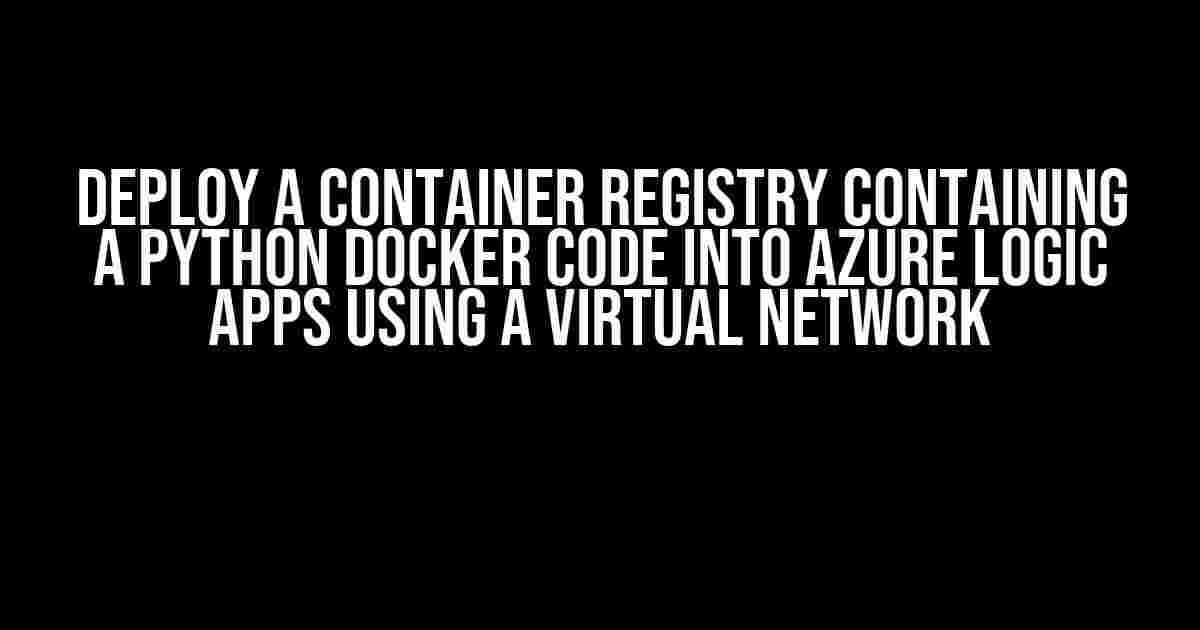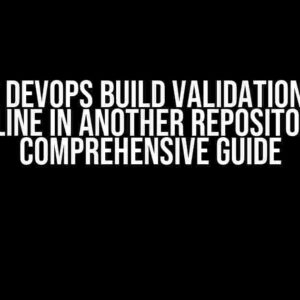Are you tired of manually deploying your Python code to Azure Logic Apps? Do you want to automate the process and ensure that your code is containerized and secure? Look no further! In this article, we’ll show you how to deploy a container registry containing a Python Docker code into Azure Logic Apps using a virtual network. Yes, you read that right – we’re talking about a seamless, automated, and secure deployment process that will make your life as a developer much easier.
- Prerequisites
- Step 1: Create a Virtual Network in Azure
- Step 2: Create an Azure Container Registry
- Step 3: Create a Python Docker Image
- Step 4: Push the Docker Image to Azure Container Registry
- Step 5: Create an Azure Logic App
- Step 6: Configure the Azure Logic App to Use the Virtual Network
- Step 7: Deploy the Container Registry to Azure Logic Apps
- Conclusion
Prerequisites
Before we dive into the tutorial, make sure you have the following prerequisites in place:
- Azure subscription
- Azure Logic Apps instance
- Docker installed on your machine
- A Python script that you want to deploy (we’ll use a simple “Hello World” example)
- A container registry (we’ll use Azure Container Registry)
- A virtual network (we’ll create a new one in Azure)
Step 1: Create a Virtual Network in Azure
Create a new virtual network in Azure by following these steps:
- Log in to your Azure portal and navigate to the “Virtual networks” section
- Click on “Create virtual network”
- Enter a name for your virtual network, select a resource group, and choose a location
- Configure the IP address range and subnet mask for your virtual network
- Click “Create” to create the virtual network
VNet Details
Here are the details for the virtual network we created:
| Property | Value |
|---|---|
| Name | my-vnet |
| Resource Group | my-resource-group |
| Location | East US |
| IP Address Range | 10.0.0.0/16 |
| Subnet Mask | 255.255.0.0 |
Step 2: Create an Azure Container Registry
Create a new container registry in Azure by following these steps:
- Log in to your Azure portal and navigate to the “Container registries” section
- Click on “Create container registry”
- Enter a name for your container registry, select a resource group, and choose a location
- Configure the SKU and pricing tier for your container registry
- Click “Create” to create the container registry
ACR Details
Here are the details for the container registry we created:
| Property | Value |
|---|---|
| Name | my-acr |
| Resource Group | my-resource-group |
| Location | East US |
| SKU | Standard |
| Pricing Tier |
Step 3: Create a Python Docker Image
Create a new Python Docker image by following these steps:
First, create a new file called `Dockerfile` with the following contents:
FROM python:3.9-alpine WORKDIR /app COPY requirements.txt . RUN pip install -r requirements.txt COPY . . CMD ["python", "app.py"]
Next, create a new file called `requirements.txt` with the following contents:
Flask==2.0.1
Finally, create a new file called `app.py` with the following contents:
from flask import Flask
app = Flask(__name__)
@app.route("/")
def hello_world():
return "Hello, World!"
if __name__ == "__main__":
app.run(debug=True, host="0.0.0.0")
Build the Docker image by running the following command:
docker build -t my-python-image .
Step 4: Push the Docker Image to Azure Container Registry
Push the Docker image to Azure Container Registry by running the following command:
docker tag my-python-image my-acr.azurecr.io/my-python-image docker push my-acr.azurecr.io/my-python-image
Step 5: Create an Azure Logic App
Create a new Azure Logic App by following these steps:
- Log in to your Azure portal and navigate to the “Logic Apps” section
- Click on “Create logic app”
- Enter a name for your logic app, select a resource group, and choose a location
- Configure the logic app settings and click “Create” to create the logic app
Logic App Details
Here are the details for the logic app we created:
| Property | Value |
|---|---|
| Name | my-logic-app |
| Resource Group | my-resource-group |
| Location | East US |
Step 6: Configure the Azure Logic App to Use the Virtual Network
Configure the Azure Logic App to use the virtual network by following these steps:
- Navigate to the “Networking” section of the logic app
- Click on “Add new network configuration”
- Select the virtual network we created earlier
- Click “Add” to add the network configuration
Step 7: Deploy the Container Registry to Azure Logic Apps
Deploy the container registry to Azure Logic Apps by following these steps:
- Navigate to the “Deployments” section of the logic app
- Click on “New deployment”
- Select “Container” as the deployment type
- Enter the container registry URL and credentials
- Select the Python Docker image we created earlier
- Click “Deploy” to deploy the container registry
Conclusion
And that’s it! We’ve successfully deployed a container registry containing a Python Docker code into Azure Logic Apps using a virtual network. This process allows us to automate the deployment of our Python code, ensure that it’s containerized and secure, and easily manage our resources in Azure.
By following these steps, you can deploy your own Python Docker code to Azure Logic Apps and take advantage of the many benefits of containerization and automation. Happy coding!
Troubleshooting Tips
If you encounter any issues during the deployment process, here are some troubleshooting tips to help you:
- Check the container registry credentials and ensure that they’re correct
- Verify that the virtual network is configured correctly and that the logic app has access to it
- Check the Python Docker image and ensure that it’s built correctly and pushed to the container registry
- Review the logic app settings and ensure that they’re configured correctly
Additional Resources
If you want to learn more about Azure Logic Apps, containerization, and automation, here are some additional resources to check out:
- Azure Logic Apps documentation: https://docs.microsoft.com/en-us/azure/logic-apps/
- Docker documentation: https://docs.docker.com/
- Azure Container Registry documentation: https://docs.microsoft.com/en-us/
Frequently Asked Questions
Got questions about deploying a container registry containing a Python Docker code into Azure Logic Apps using a virtual network? We’ve got answers!
Q1: What is a container registry, and why do I need it to deploy my Python Docker code?
A container registry is a service that stores and manages container images. Think of it like a library where you store your Docker images, and Azure Container Registry (ACR) is one of the most popular ones. You need a container registry to deploy your Python Docker code because it allows you to push your image to a secure, scalable, and highly available registry, making it easy to deploy and manage your containers in Azure Logic Apps.
Q2: How do I create a container registry in Azure, and what are the benefits of using Azure Container Registry (ACR)?
To create a container registry in Azure, simply navigate to the Azure portal, search for “Container Registry”, and follow the prompt to create a new registry. Azure Container Registry (ACR) offers a ton of benefits, including geo-replication, webhook notifications, and Azure Active Directory (AAD) authentication. With ACR, you get enterprise-grade security, scalability, and reliability, making it the perfect choice for deploying your Python Docker code.
Q3: What is a virtual network (VNet) in Azure, and why do I need it to deploy my container registry?
A virtual network (VNet) is a virtual private cloud that you can create in Azure, allowing you to define your own private IP address space and connect to Azure services. You need a VNet to deploy your container registry because it provides a secure and isolated environment for your containers to communicate with each other and with other Azure resources. By deploying your container registry in a VNet, you get enhanced security, networking control, and flexibility.
Q4: How do I deploy my Python Docker code to Azure Logic Apps using a virtual network?
To deploy your Python Docker code to Azure Logic Apps using a virtual network, you’ll need to create a new Azure Logic App, add a “Containers” action, and specify the VNet and container registry details. Then, you can upload your Docker image to the container registry, and Azure Logic Apps will take care of the rest, spinning up a new container instance based on your Python code. Easy peasy!
Q5: What are some best practices for securing my container registry and virtual network in Azure?
When it comes to securing your container registry and virtual network in Azure, remember to use Azure Active Directory (AAD) authentication, enable geo-replication, and configure network policies and access controls. You should also regularly scan your container images for vulnerabilities, use secure protocols for communication, and limit access to your registry and VNet using Azure role-based access control (RBAC). By following these best practices, you’ll be well on your way to a secure and reliable deployment!





